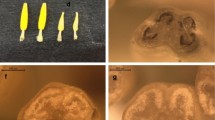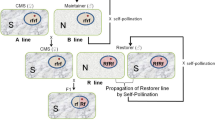Abstract
The male sterility system in hybrid seed production can eliminate the cost of emasculation and ensure seed hybridity through avoidance of self pollination. GMS and CMS are two types of male sterility system that currently employed in pepper breeding. Conversion from GMS to CMS will increase the male sterility proportion of female parent from 50 to 100%. In this study, segregation analysis of four male sterile mutants consisting of one CMS mutant (CA1) and three GMS mutants (GA1, GA3 and GA4) showed that each had single recessive gene inheritance. A modified complementation test was performed by replacing male sterile mutants with their maintainer line as male parent. The nuclear restorer gene for CMS was independent of all nuclear restorer genes for GMS and all nuclear restorer genes for GMS were independent each other. Further observation on CMS and GMS male sterility loci revealed that GA1 and GA3 had mutated in both nuclear restorer genes for CMS and GMS, while CA1 and GA4 each carried mutation in single male sterility system of nuclear restorer gene for CMS and GMS, respectively. Conversion from GMS to CMS in the case of lines carried mutations in both sterility systems required only S-type cytoplasm donor, while lines carried mutation in single nuclear restorer gene for GMS required not only S-type cytoplasm but also rf allele donors. The important finding is the broader function of maintainer line in certain male sterility system that can be used as a maintainer or restorer line for other male sterility systems. We also confirmed that line CC1 is the general restorer for both CMS and GMS systems.

Similar content being viewed by others
References
Evenor D, Guri A, Izhar S (1984) The relationship between a nuclear restorer gene and the nuclear gene for male sterility in Petunia. Theor Appl Genet 67:475–478. doi:10.1007/BF00263416
Frankel R, Galun E (1977) Pollination Mechanism, Reproduction and Plant breeding. Springer-Verlag Berlin Heidelberg, New York, p 281
Gulyas G, Pakodzi K, Lee JS, Hirata Y (2006) Analysis of fertility restoration by using cytoplasmic male-sterile red pepper (Capsicum annuum L.) lines. Breed Sci 56:331–334. doi:10.1270/jsbbs.56.331
Jan CC, Vick BA (2007) Inheritance and allelic relationships of fertility restoration genes for seven new sources of male-sterile cytoplasm in sunflower. Plant Breed 126:213–217. doi:10.1111/j.1439-0523.2007.01350.x
Kim DH, Kim BD (2005) Development of SCAR markers for early identification of cytoplasmic male sterility genotype in chili pepper (Capsicum annuum L.). Mol Cell 20:416–422. doi:10.1016/j.molcel.2005.11.012
Kim DS, Kim DH, Yoo JY, Kim BD (2006) Cleaved amplified polymorphic sequence and amplified fragment length polymorphism markers linked to the fertility restorer gene in chili pepper (Capsicum annuum L.). Mol Cell 21:135–140. doi:10.1016/j.molcel.2005.11.014
Lee JD (2003) Development of AFLP marker linked to gene responsible for stable fertility in cytoplasmic-genic male sterility of chili pepper (Capsicum annuum L.). Master Thesis Department of Horticultural Science The Graduate School of Seoul National University, 44 pp
Lee JD, Yoon JB, Park HG (2008a) A CAPS marker associated with the partial restoration of cytoplasmic male sterility in chili pepper (Capsicum annuum L.). Mol Breed 21:95–104. doi:10.1007/s11032-007-9111-0
Lee JD, Yoon JB, Park HG (2008b) Linkage analysis between the partial restoration (pr) and the restorer-of-fertility (Rf) loci in pepper cytoplasmic male sterility. Theor Appl Genet 117:383–389. doi:10.1007/s00122-008-0782-7
Liu F, Cui XQ, Horner HT, Weiner H, Schnable PS (2001) Mitochondrial aldehyde dehydrogenase activity is required for male fertility in maize. Plant Cell 13:1063–1078
Luo XD, Dai LF, Wang SB, Wolukau JN, Jahn M, Chen JF (2006) Male gamete development and early tapetal degeneration in cytoplasmic male-sterile pepper investigated by meiotic, anatomical and ultrastructural analyses. Plant Breed 125:395–399. doi:10.1111/j.1439-0523.2006.01238.x
Martin JA, Crawford JH (1951) Several types of sterility in Capsicum frutescens. Proc Am Soc Hortic Sci 57:335–338
Peterson PA (1958) Cytoplasmically inherited male sterility in Capsicum. Am Nat 92:111–119. doi:10.1086/282017
Shifriss C (1973) Additional spontaneous male-sterile mutant in Capsicum annuum L. Euphytica 22:527–529. doi:10.1007/BF00036651
Shifriss C (1997) Male sterility in pepper (Capsicum annuum L.). Euphytica 93:83–88. doi:10.1023/A:1002947907046
Shifriss C, Frankel R (1969) A new male sterility gene in Capsicum annuum L. J Am Soc Hortic Sci 94:385–387
Shifriss C, Frankel R (1971) New sources of cytoplasmic male sterility in cultivated peppers. J Hered 64:254–256
Shifriss C, Pilovsky M (1993) Digenic nature of male sterility in pepper (Capsicum annuum L.). Euphytica 67:111–112. doi:10.1007/BF00022733
Shifriss C, Rylsky I (1972) A male sterile (ms-2) gene in ‘California Wonder’ pepper (Capsicum annuum L.). HortScience 7:36
Tang HV, Pring DR (2003) Conversion of fertility restoration of the sorghum IS1112C (A3) male sterile cytoplasm from two genes to one gene. Crop Sci 43:1747–1753
Wang LH, Chang BX, Lefebvre V, Huang SW, Daubeze AM, Palloix A (2004) QTL analysis of fertility restoration in cytoplasmic male sterile pepper. Theor Appl Genet 109:1058–1063. doi:10.1007/s00122-004-1715-8
Wang ZH, Zou YJ, Li XY, Zhang QY, Chen LT, Wu H, Su DH, Chen YL, Guo JX, Luo D, Long YM, Zhong Y, Liu YG (2006) Cytoplasmic male sterility of rice with Boro II cytoplasm is caused by a cytotoxic peptide and is restored by two related PPR motif gene via distinct modes of mRNA silencing. Plant Cell 18:676–687. doi:10.1105/tpc.105.038240
Wang ZW, Zhang YJ, Xiang CP, Mei SY, Zhou YA, Chen GP, Wang T (2008) A new fertility restorer locus linked closely to the Rfo locus for cytoplasmic male sterility in radish. Theor Appl Genet 117:313–320. doi:10.1007/s00122-008-0776-5
Woong Yu I (1990) The inheritance of male sterility and its utilization for breeding in pepper (Capsicum spp.). PhD thesis, Kyung Hee University, South Korea, pp 1–70
Zhang BX, Huang SW, Yang GM, Guo JZ (2000) Two RAPD markers linked to a major fertility restorer gene in pepper. Euphytica 113:155–161. doi:10.1023/A:1003945723196
Acknowledgments
The authors thank Dr. Anne Frary and Dr. Rudy Lukman for critical reading and helpful suggestions of this manuscript.
Author information
Authors and Affiliations
Corresponding author
Rights and permissions
About this article
Cite this article
Mulyantoro, Chen, SY., Wahyono, A. et al. Modified complementation test of male sterility mutants in pepper (Capsicum annuum L.): preliminary study to convert male sterility system from GMS to CMS. Euphytica 169, 353–361 (2009). https://doi.org/10.1007/s10681-009-9968-6
Received:
Accepted:
Published:
Issue Date:
DOI: https://doi.org/10.1007/s10681-009-9968-6




